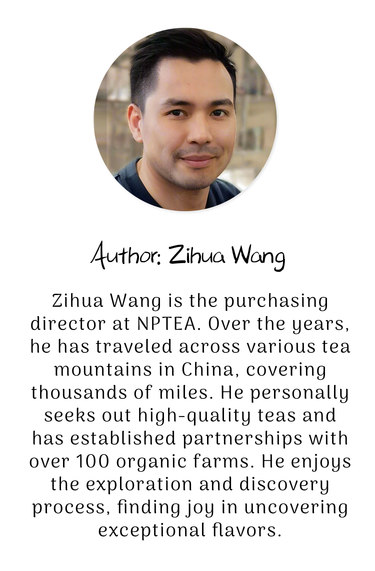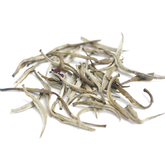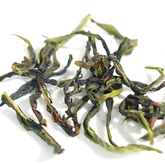A Complete Guide to Phoenix Dan Cong: Origins, Taste, Brewing Tips, and Health Benefits
Phoenix Dancong is a famous Chinese oolong tea , with a tea-producing history of over 900 years. As a semi-oxidized tea and a member of the six major types of Chinese tea , it is often honored as the "perfume of tea" for its captivating natural aroma.
What truly sets Phoenix Dancong apart is not just a single flavor note, but its complex and enchanting fragrance—floral, fruity, honeyed, woody, milky. Different Dancong varieties originate from different tea tree cultivars, and the aromatic profile varies by the mountain location where the leaves are picked. These aromas are not artificially blended but are naturally developed from the tea itself.
This article offers a full overview of Phoenix Dancong’s origin, processing techniques, aroma types, tasting experience, and brewing tips, along with practical advice for purchasing. If you're curious about oolong tea, Phoenix Dancong is a fantastic introduction.
Recommended purchase:
Oolong Tea-Phoenix Dan Cong YouHuaXiang

Origin of Phoenix Dancong
Phoenix Dancong comes from Phoenix Mountain (Fenghuang Shan) in Chaozhou , Guangdong Province, which is also the birthplace of traditional Chinese gongfu tea. With over 700 years of tea cultivation history, it is one of the most important oolong tea producing regions in China.
History of Phoenix Dancong
Phoenix Dancong has a deeply rooted history, with written records tracing it back to the late Southern Song Dynasty (13th century). According to legend, an emperor passing through Chaozhou sampled a local tea from Phoenix Mountain, particularly drawn to the unique “Ya Shi Xiang” ("Duck Shit Aroma") variety, which later earned fame throughout China.

By the late 19th and early 20th centuries, as China’s tea exports expanded globally, Phoenix Dancong began to appear in international markets, attracting global tea lovers with its rich aroma and sophisticated character.
How Phoenix Dancong Is Made
Phoenix Dancong follows a classic oolong tea production process, considered one of the most intricate among all Chinese tea types. Key steps rely heavily on skilled craftsmanship and manual labor, which results in a higher cost and limited production. High-quality Phoenix Dancong is relatively rare and expensive.

Unlike white tea ("no frying, no rolling") or fully oxidized black tea, Phoenix Dancong involves multiple complex and manual steps. Each phase is crucial for developing its signature fragrance and flavor. The key stages are:
Picking: Tender leaves are hand-picked following strict standards.
Sun-Withering: Leaves are spread under sunlight or in a ventilated area to reduce moisture and prepare for fermentation.
Cooling: The leaves are then cooled indoors to balance internal and external moisture.
Fermentation (Zuo Qing): The most critical and complex step. The leaves are tossed and rested repeatedly in bamboo trays or machines to initiate enzymatic oxidation. Skilled tea makers control the shaking intensity and timing precisely, often repeating this step 5–8 times or more.
Fixation (Sha Qing): High heat halts further oxidation, locking in aroma and flavor.
Rolling: Leaves are gently rolled to release juices and shape them into strips, enhancing their extractability during brewing.
Baking (Roasting): A two-phase process—initial and secondary baking—further dries the leaves, removes grassy notes, and enhances aroma. Some varieties undergo multiple rounds to achieve deeper flavor and signature roasted notes.
What Does Phoenix Dancong Taste Like?
For Western tea drinkers unfamiliar with Chinese oolong teas, tasting Phoenix Dancong is like uncorking a fine perfume bottle—except this one you can drink. Each aroma type originates from the tea itself, not additives.
Its flavor is layered and distinctive, with clear differences between lightly oxidized and medium oxidized versions:
Lightly oxidized Dancong: Floral & Fresh
Aroma: Soft orchid and jasmine notes with green apple and citrus zest. It’s like a well-balanced white wine or a glass of sparkling water infused with blossoms.
Taste: Light and silky. The tea melts on your tongue with a fresh grassiness and gentle honey-like sweetness. A clean, minty aftertaste lingers, leaving your mouth cool and refreshed.
Medium oxidized Dancong: Toasty & Rich
Aroma: Candied citrus, caramel, toasted nuts, and ripe apples. Reminiscent of a lightly roasted specialty coffee.
Taste: Round and full-bodied. It opens with a mellow caramel note, develops into layers of pine wood and honey sweetness, and finishes with a deep, slow-releasing aroma at the back of the tongue.
How to Brew Phoenix Dancong
To fully enjoy the rich aroma and taste of Phoenix Dancong, we highly recommend using the gongfu tea method. Avoid brewing with a mug or Western-style teapot, as this often leads to bitterness and under-extraction.(Further Reading: What Is A Gaiwan? )

Gongfu-style brewing with a gaiwan or small Yixing clay teapot allows precise control and helps release the full complexity of the tea. Boiling water (212°F / 100°C) is essential for Phoenix oolong to bloom properly.(Further Reading: A Beginner's Guide To Traditional Chinese KungFu Cha)
Water-to-tea ratio: Use 6–8g of tea in a 100–120ml gaiwan or small teapot.Water temperature: Always use boiling water (100°C/212°F), especially for medium-oxidized or roasted varieties. Lower temperatures mute aroma and flavor.
Steep time: For the first 2–3 infusions, steep quickly (5–10 seconds) to avoid bitterness. Gradually increase steeping time with each round.
How to Store Phoenix Dancong
Phoenix Dancong is best consumed within 1–2 years for optimal aroma and flavor. Proper storage is critical due to its roasted, low-moisture nature, which makes it particularly vulnerable to moisture, light, oxygen, and strong odors.(Further Reading: How To Properly Store Your Tea? )
Airtight storage: Always keep tea in sealed containers—ceramic jars with rubber seals, stainless steel tins, or foil-lined bags.
Dry environment: Store in a cool, dry place—avoid kitchens or bathrooms where humidity is high.
Light protection: Keep away from sunlight. Exposure speeds up the breakdown of aromatic compounds.
Avoid odor contamination: Tea is highly absorbent. Do not store near coffee, spices, or household cleaners. Minimize exposure to air by opening the container as little as possible.
Health Benefits of Phoenix Dancong
In southern China, it's common to see children as young as six brewing tea with a gaiwan alongside their parents. In Chaozhou, this tradition of drinking Phoenix Dancong as a daily beverage has been passed down for centuries—proof enough that it's a natural and health-conscious drink.(Further Reading: Is Pure Leaf Tea Healthy? )

Modern research backs up these traditional beliefs. As a semi-oxidized tea, Phoenix Dancong retains abundant bioactive compounds that offer multiple science-backed health benefits:
Strong antioxidants, slow aging
Rich in polyphenols and catechins (like EGCG), Dancong combats oxidative stress and supports skin and cell health. Studies show that oolong tea can reduce oxidative biomarkers significantly (Chen et al., Food Funct., 2015).
Supports fat metabolism and weight control
Oolong polyphenols help block fat absorption and enhance fat burning. Drinking 2–3 cups (300ml daily) for 12 weeks has been linked to lower body fat (Hsu et al., Int. J. Obes., 2009).
Promotes heart health
Tea flavonoids improve cholesterol profiles and prevent LDL oxidation, reducing atherosclerosis risk. Regular oolong drinkers have up to 20% lower risk of heart disease (Khan et al., Eur. J. Clin. Nutr., 2018).
Aids digestion and reduces greasiness
The tea’s polyphenols and volatile oils promote digestion, reduce bloating, and balance rich meals (Zheng et al., Food Funct., 2015).
Oral health, cavity prevention
Tea polyphenols fight oral bacteria and reduce plaque formation, supporting dental hygiene (Parkar et al., Nutr. Rev., 2013).
Improves alertness and brain health
A combination of caffeine and L-theanine enhances mental clarity and reduces stress. Long-term tea drinkers show better cognitive performance (Kuriyama et al., PLoS One, 2013).
Summary of Phoenix Dancong
Phoenix Dancong originates from Phoenix Mountain in Chaozhou, a core oolong-growing region in China. Revered as the “perfume of tea”, it boasts over 900 years of history and heritage.
Due to the labor-intensive and highly skilled production process, top-quality Phoenix Dancong is both rare and premium. Its hallmark aroma makes it a perfect candidate for gongfu-style brewing, not mugs or teapots that mute its complexity.
With centuries of use and growing scientific evidence, Phoenix Dancong is clearly a healthy, natural beverage. For anyone interested in Chinese oolong tea, this is a must-try—it may just change the way you think about tea forever.
FAQs About Phoenix Dancong
Q1: Does Phoenix Dancong contain caffeine?
A: Yes, as an oolong tea, it contains moderate levels of caffeine—less than coffee but more than most green teas.
Q2: How much caffeine is in Phoenix Dancong?
A: Around 20–50mg per 8oz cup (240ml), depending on variety, oxidation, and brewing method.
Q3: What does Phoenix Dancong taste like?
A: It’s famous for natural floral and fruity aromas. Lightly oxidized teas are fresh and aromatic; medium-oxidized ones are rich, honeyed, and slightly toasty.
Q4: Can Phoenix Dancong be aged or stored long term?
A: Best consumed within 1–2 years for peak freshness and aroma.
Q5: What health benefits does Phoenix Dancong offer?
A: It’s rich in antioxidants, boosts metabolism, supports digestion and heart health, and helps with relaxation and mental clarity.
SEE MORE ABOUT TEA
If you are a beginner about Chinese tea:
Basic-Guide-to-Chinese-Tea
If you have questions about selecting tea:
Learn-more-about-chinese-tea
If you have questions about the benefits of tea:
Health-benefits-of-chinese-tea
If you have questions about brewing tea:
How-to-brew-loose-leaf-tea






